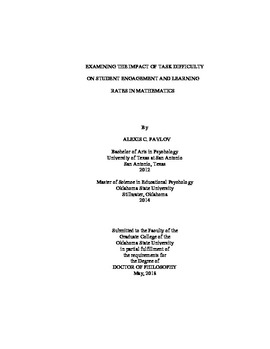| dc.contributor.advisor | Duhon, Gary J. | |
| dc.contributor.author | Pavlov, Alexis C. | |
| dc.date.accessioned | 2019-03-22T18:57:12Z | |
| dc.date.available | 2019-03-22T18:57:12Z | |
| dc.date.issued | 2018-05 | |
| dc.identifier.uri | https://hdl.handle.net/11244/317665 | |
| dc.description.abstract | Modifying task difficulty has been examined in the research as a relatively non-invasive antecedent-intervention to address both behavior and academic problems for students. The current study aimed to examine the effects of task difficulty on engagement at the class-wide level. In addition, growth rates were examined to determine if there were significant differences between levels of task difficulty when engagement was controlled for. Participants consisted of 56 fourth grade students in three general education classrooms in central Oklahoma. Participants were assigned to an easy and difficult math skill utilizing curriculum-based assessments. Easy probes were defined as math skills in which a student scored 30-50 DCPM and difficult probes were math skills in which a student scored less than 20 DCPM. In study 1, student behavior was audio and video taped during 5-minute sessions for both conditions. In study 2, engagement was held constant to the time students were engaged on the difficulty probes in study 1 therefore students were given two minutes and 39 second sessions. Engagement was later assessed using systematic observations for on-task behavior and growth was assessed using DCPM scores on daily math probes. Results from study 1 indicated statistically significant differences between the easy and difficult probe conditions. The easy condition resulted in significantly more DCPM session growth at a faster rate than the difficult condition. On average, students grew 1.16 DCPM more per session in the easy condition. Students were also significantly more on-task in the easy probe condition than the difficult probe condition with the odds of on-task behavior in the easy condition being 1.666 greater than the difficult condition. Findings in study 2 indicated that while both conditions resulted in continual DCPM growth over time, the growth was substantially less than in study 1. The interaction between task difficulty and growth was not significant which suggests that engagement was a substantial contributor to the growth differences in study 1. Limitations to the study include possible maturation, lack of generalizability due to the use of only one grade level of participants in general education placements, and generalizability of results across curricular areas. | |
| dc.format | application/pdf | |
| dc.language | en_US | |
| dc.rights | Copyright is held by the author who has granted the Oklahoma State University Library the non-exclusive right to share this material in its institutional repository. Contact Digital Library Services at lib-dls@okstate.edu or 405-744-9161 for the permission policy on the use, reproduction or distribution of this material. | |
| dc.title | Examining the impact of task difficulty on student engagement and learning rates in mathematics | |
| dc.contributor.committeeMember | Poncy, Brian C. | |
| dc.contributor.committeeMember | Rich, Sara E. House | |
| dc.contributor.committeeMember | Davis, Robert Evan | |
| osu.filename | Pavlov_okstate_0664D_15586.pdf | |
| osu.accesstype | Open Access | |
| dc.type.genre | Dissertation | |
| dc.type.material | Text | |
| thesis.degree.discipline | Educational Psychology | |
| thesis.degree.grantor | Oklahoma State University | |
